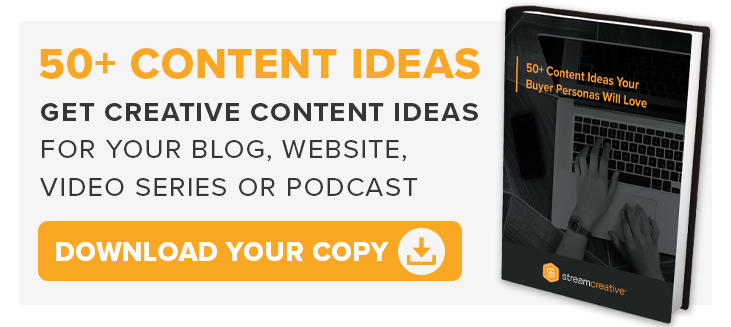 We're all familiar with the phrase "content is king". Since being coined in 1996 by Bill Gates, it's been overworked in articles and blogs across the internet. Are you sick of hearing it? Maybe. Is it still true? Absolutely.
We're all familiar with the phrase "content is king". Since being coined in 1996 by Bill Gates, it's been overworked in articles and blogs across the internet. Are you sick of hearing it? Maybe. Is it still true? Absolutely.
Having a consistent stream of fresh content is a crucial part of a successful content strategy. But as any content creator will tell you, it's all too easy to get burned out. So we've put together a list of over 50 types of content (broken up into eight categories) to help you get the creative juices flowing!
Apply these ideas to your blog, website, videos or podcasts to start generating more traffic and leads. Once you've found some inspiration, jump to the bottom of our blog to take your content strategy to the next level!
Jump To Content Categories:
- How-To-Articles
- Explainer Educational Articles
- Reviews
- Expert Interviews
- Case Studies
- News Stories
- Insightful Posts
- Opposing Viewpoints
- BONUS: Getting Started With Your Content Strategy
1. How-To-Articles
Practical articles of useful information that helps your readers solve important problems or reach new levels of expertise. It’s a good idea to make these types of posts a major staple of your blog’s editorial calendar by publishing them frequently.
- Video – create a video, posting to YouTube, Wistia, etc., and embed on your blog
- List – a numbered list of tips, how-to’s, stats, ways, examples, practices, etc.
- Contest – post a quiz on a topic and give a prize/recognition to the best response
- Feature or Series – creating an ongoing series of articles on a theme/topic
- Common Mistakes – a list of common mistakes and how to overcome them
- FAQs – answer commonly asked questions
- Best Of – a description of top rated tools, products or services
- Tips & Tricks – sharing helpful techniques or ways to do something better
- Recommended Resources – providing a list of recommended reading on a topic
- Checklist – post a checklist of items needed to accomplish some activity or goal
- Cheat Sheet – providing shortcuts to make a particular task easier to perform
- Lessons Learned – discuss a mistake and what you learned from it
2. Explainer Educational Articles
You are an expert in your industry. Share that knowledge using articles and insights to educate and inform your readers.
- Define a Term or Concept – define a key industry term and highlight your expertise
- Product Overview – do you have a unique product? How does your product solve customer problems?
- Process Review – explain your unique process for product development or design
- Video – highlight an industry expert, demonstrate a process, or show a product being made
- Q+A – educate readers with a back and forth format
3. Reviews
Reviews with a summary and objective opinions covering books, products, services, Web sites, research, surveys, or studies your reader base cares about and are an excellent way to draw in, help and involve others.
- Books – give an overview and honest assessment with tips and ratings
- Surveys – conduct a survey and give the results with insights on what it means
- Polls – conduct a topical poll and share the results
- Best Of – compare and contrast a list of top tools, products or services
- Recommended Resources – similar to “best of”
- Reports, Studies or Research – overview and analysis of comprehensive materials
- Themed Article – illustrate a central theme with a book author’s viewpoint or example
4. Expert Interviews
Written, audio or video interviews with people who have expert industry or topical knowledge relevant to your reader base. These are a great source of traffic and engagement.
- Video – create at events or locations where experts, speakers, or authors are present
- Guest Posts – invite experts, authors, and industry leaders to post articles on your blog
- Written – record a phone or in-person interview, transcribe, edit and post
- Audio – same as “written” but posted on site or podcast as audio content
- Hybrid – mix video and written, or audio and written to post on the blog
HOT TIP: While a video interview can very engaging on it's own, it's a best practice to always have a transcription of the video (preferably lower on the page). This is better for two main reasons 1) SEO and 2) it makes your content more accessible to all types of visitors.
5. Case Studies
Used to examine the challenges and successes businesses and people in your industry have experienced that your readers can relate to and be inspired by. These are extremely valuable to connect with your audience and resonate with their needs and desires.
- Story Blog – tell an authentic story of how a business or person overcame something
- Inside Look – reveal how something was improved or taken to new levels
- Video Story – tell the story with your subject in a video interview format
- Tips & Tricks – do a video, audio and/or written story in a tips and tricks format
- Recommended Resources – for using a select group of people or products
- Lessons Learned – format a success story to cover unexpected outcomes or benefits
6. News Stories
Publish stories about the latest industry developments, trends or happenings your readers would be interested in hearing about.
- Piggyback – write a commentary on a recent news story offering your unique point of view
- Response – give a response to address an issue, crisis or challenge
- Breaking – be the first to break a news story, or announce something of value
- Weekly Summary – feature the top news, articles, etc., of the previous week
- Event Summary – share highlights, impressions, insights of an event you attended
- Live Blogging – post updates of a real-time event, “as it happens”
- Repost – modify and post a news release that was published via online newswire service
- Prediction – take a news story and make a prediction on how it may turn out
- Industry News – discuss current events or topics with commentary on what it means
7. Insightful Posts
You can inspire or champion a particular cause, aspiration or goal you believe in and know is important to your reader base.
- Thought Leadership – share your position, idea or viewpoint on a particular topic
- Awe-Inspiring – posts that inspire a sense of awesomeness in a particular ideal
- Response – a direct response to a challenge or crisis situation
- Humor – poke some fun at yourself, a topic, your industry or share a humorous story
- Prediction – make a forecast or contradict one made by someone else
- Deep Dive – take a closer look at something others regard as worthless or highly valuable
8. Opposing Viewpoints
Occasionally, consider articles that dispel or take an opposing view of commonly held beliefs and practices being talked about in your industry.
- Opposing View – reveal and discuss a differing position on a topic or issue
- Compare or Contrast – discuss the differences or similarities of two concepts or terms
- Myth Busting – dispel a commonly held belief and show why it’s no longer valid
- Trouble With – discuss the “dark side” of something with an alternative viewpoint
- Different Dimension – show where the gaps are and offer a better way
Getting Started With Your New Content Strategy
Whew! That's a lot of content options, now comes the big question: what type of content should you create first? Consider these steps:
Step 1: Do a Content Audit of Your Previously Published Static Content
Knowing what you already have will keep you from repeating work. Some of your existing content that's not performing well may even be a few minor improvements away from being a significant draw to your website. Start with these to get some quick wins under your belt.
Step 2: Repurpose Content Into New Incarnations
Got a blog with useful content that's not bringing in views? Consider repurposing it as an infographic or video. Maybe that video from a year ago would be better received as a blog series?
By reimagining the same information in different forms, you create new content while saving time on research and test to see what is the best medium for that information to be presented.
Examples of Different Mediums to Present Content:
Downloads (ebook, checklist, etc), video, blog, infographic, or social series.
Step 3: Optimize and Promote
So you have all this fantastic content. Now you need to keep reminding people about it. Start by publishing CTAs on your web pages with relevant content and promoting on your social media calendar. To take things further, consider a paid promotion strategy on Google AdWords, Facebook, and LinkedIn.
Before people start downloading your content, develop workflow content for email nurturing. This is your chance to promote more content of yours to an audience that has expressed interest.
3 Email Workflow Example:
You are a website that sells used books. Someone has just downloaded your checklist of Summer Reading Suggestions For High Schoolers. Your workflow should follow an order similar to this:
Email 1: Thank you for downloading! Here is your resource, and contact info in case you need more information.
Email 2: Because of your interest in "Summer Reading Suggestions For High Schoolers," we recommend these college prep resources!
Email 3: Your business's primary call to action. "Visit this page to order from our library!"
Step 4: Tap Into Your Customer-Facing Teams for Content Ideas
Find out the questions and problems customers face as they interact with your sales, customer service, and accounting teams. Make that content a priority, then create and publish content in as many owned, paid and shared media channels as possible.
We hope this list helps you out on those days when the creative process feels more like the vegetative process. You can download your own copy of 50+ Content Ideas Your Buyer Personas Will Love below!
If you need help with your creative campaign, give us a shout! We'd love to help :)














